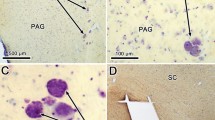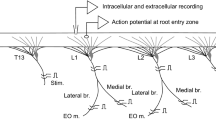Summary
Neurons found in the medial bulbar reticular formation were activated by stimulation of the orbital gyms and responded with antidromic spike potentials to selective stimulation of either the masseter or anterior digastric motoneuron pool in the trigeminal motor nucleus in cats anesthetized with α-chloralose. These two kinds of reticular neurons were assumed to be inhibitory neurons projecting to masseter motoneurons (IM neurons) and excitatory neurons projecting to anterior digastric motoneurons (ED neurons), involved in the effects of stimulation of the orbital gyrus on trigeminal motoneurons: inhibition of masseter motoneurons and excitation of anterior digastric motoneurons.
Input-output properties of IM and ED neurons were studied intracellularly with the following results: (1) stimulation of the orbital gyrus evoked EPSPs in im and ED neurons with mono- and polysynaptic latencies; and (2) stimulation of the lingual nerve evoked a spike potential in a few IM and ED neurons after a rather long latency, indicating that the pathways involved in the cortical control of trigeminal motoneurons via IM and ED neurons were basically separate from those responsible for the reflex control by the peripheral inputs
Intracellular injection of horseradish peroxidase revealed that both IM and ED neurons were small or medium in size and the former were smaller than the latter, while none of the large reticular neurons directly projected to the trigeminal motor nucleus. This suggests a possible functional differentiation among bulbar reticular neurons according to cell size.
Similar content being viewed by others
References
Abzug C, Maeda M, Peterson BW, Wilson VJ (1974) Cervical branching of lumbar vestibulospinal axons. J Physiol (Lond) 243: 499–532
Baldissera F, Lundberg A, Udo M (1972) Stimulation of pre- and postsynaptic elements in the red nucleus. Exp Brain Res 15: 151–167
Batini C, Buisseret-Delmas C, Corvisier J (1976) Horseradish peroxidase localization of masticatory muscle motoneuron in cat. J Physiol (Paris) 72: 301–309
Brodal A (1957) The reticular formation of the brain stem. Anatomical aspects and functional correlates. Oliver and Boyd, Edingburgh
Chase MH, McGinty DJ (1970a) Modulation of spontaneous and reflex activity of the jaw musculature by orbital cortical stimulation in the freely-moving cat. Brain Res 19: 117–126
Chase MH, McGinty DJ (1970b) Somatomotor inhibition and excitation by forebrain stimulation during sleep and wakefulness. Brain Res 19: 127–136
Dellow PG, Lund JP (1971) Evidence for central timing of rhythmical mastication. J Physiol (Lond) 215: 1–13
Enomoto S, Katoh M, Hiraba K, Nakamura Y (1981) Masticatory rhythm in bulbar reticular neurons induced by stimulation of the orbital gyrus in immobilized cats. Neurosci Lett [Suppl] 6: S16
Goldberg LJ, Nakamura Y (1968) Lingually induced inhibition of masseteric motoneurones. Experientia 24: 371–373
Hess WR, Akert K, McDonald DA (1952) Functions of the orbitalgyri of cats. Brain 75: 244–258
Holstege G, Kuypers HGJM (1977) Propriobulbar fibre connections to the trigeminal, facial and hypoglossal motor nuclei. I. An anterograde degeneration study in the cat. Brain 100: 239–264
Holstege G, Kuypers HGJM, Dekker JJ (1977) The organization of the bulbar fibre connections to the trigeminal, facial and hypoglossal motor nuclei. II. An autoradiographic tracing study in cat. Brain 100: 265–286
Jankowska E, Roberts WJ (1972) Synaptic actions of single interneurones mediating reciprocal la inhibition of motoneurones. J Physiol (Lond) 222: 623–642
Kawamura Y, Tsukamoto S (1960) Analysis of jaw movements from the cortical jaw motor area and amygdala. Jpn J Physiol 10: 471–488
Kidokoro Y, Kubota K, Shuto S, Sumino R (1968) Possible interneurons responsible for reflex inhibition of motoneurons of jaw closing muscles from the inferior dental nerve. J Neurophysiol 31: 709–716
Kuypers HGJM (1958) An anatomical analysis of corticobulbar connexions to the pons and lower brain stem in the cat. J Anat 92: 198–218
Landgren S, Olsson KÅ (1976) Localization of evoked potentials in the digastric, masseteric, supra- and intertrigeminal sub-nuclei of the cat. Exp Brain Res 26: 299–318
Lund JP, Lamarre Y (1974) Activity of neurons in the lower precentral cortex during voluntary and rhythmical jaw movements in the monkey. Exp Brain Res 19: 282–299
Magoun HW, Ranson SW, Fisher C (1933) Corticifugal pathways for mastication, lapping and other motor functions in the cat. Arch Neurol Psychiat (Chic) 30: 292–308
Miller FR (1920) The cortical paths for mastication and deglutition. J Physiol (Lond) 53: 473–478
Mizuno N, Konishi A, Sato M (1975) Localization of masticatory motoneurons in the cat and rat by means of retrograde axonal transport of horseradish peroxidase. J Comp Neurol 164: 105–116
Mizuno N, Sauerland EK, Clemente CD (1968) Projections from the orbital gyrus in the cat. I. To brain stem structures. J Comp Neurol 133: 463–476
Morimoto T, Kawamura Y (1973) Properties of tongue and jaw movements elicited by stimulation of the orbital gyrus in the cat. Arch Oral Biol 18: 361–372
Nakamura Y, Enomoto S, Kalo M (1980) The role of the medial bulbar reticular neurons in the orbital cortically induced masticatory rhythm in cats. Brain Res 202: 207–212
Nakamura Y, Goldberg LJ, Clemente CD (1967) Nature of suppression of the masseteric monosynaptic reflex induced by stimulation of orbital gyrus of the cat. Brain Res 6: 184–198
Nakamura Y, Katoh M, Enomoto S, Hiraba K (1982) Neural pathway involved in the excitation of motoneurones to jaw-opening muscles by stimulation of the orbital cerebral cortex in the cat. Arch Oral Biol 27: 283–287
Nakamura Y, Kubo Y, Nozaki S, Takatori M (1976a) Cortically induced masticatory rhythm and its modification by tonic peripheral inputs in immobilized cats. Bull Tokyo Med Dent Univ 23: 101–107
Nakamura Y, Mori S, Nagashima H (1973) Origin and central pathways of crossed inhibitory effects of afferents from the masseteric muscle on the masseteric motoneuron of the cat. Brain Res 57: 29–42
Nakamura Y, Nozaki S, Takatori M, Kikuchi M (1976b) Possible inhibitory neurons in the bulbar reticular formation in the cortically evoked inhibition of the masseteric motoneuron of the cat. Brain Res 115: 512–517
Ranck JB Jr (1975) Which elements are excited in electrical stimulation of mammalian nervous system: a review. Brain Res 98: 417–440
Rioch JM (1934) The neural mechanism of mastication. Am J Physiol 108: 168–176
Sauerland EK, Knauss T, Nakamura Y, Clemente CD (1967a) Inhibition of monosynaptic and polysynaptic reflexes and muscle tone by electrical stimulation of the cerebral cortex. Exp Neurol 17: 159–171
Sauerland EK, Nakamura Y, Clemente CD (1967b) The role of the lower brain stem in cortically induced inhibition of somatic reflexes in the cat. Brain Res 6: 164–180
Sumi T (1969) Some properties of cortically-induced swallowing and chewing in rabbits. Brain Res 15: 107–120
Sumino R (1971) Central neural pathways involved in the jaw opening reflex in the cat. In: Dubner R, Kawamura Y (eds) Oral-facial sensory and motor mechanisms. Appleton-Century-Crofts, New York, pp 315–331
Takahashi K (1965) Slow and fast groups of pyramidal tract cells and their respective membrane properties. J Neurophysiol 28: 908–924
Takatori M, Nozaki S, Nakamura Y (1981) Control of trigeminal motoneurons exerted from bulbar reticular formation in the cat. Exp Neurol 72: 122–140
Vogt C, Vogt O (1926) Die vergleichend-architektonische und die vergleichend-reizphysiologische Felderung der Großhirnrinde unter besonderer Berücksichtigung der menschlichen. Naturwissenschaften 14: 1190–1194
Walker AE, Green HD (1938) Electrical excitability of the motor face area: a comparative study in primates. J Neurophysiol 1: 152–165
Ward JW, Clark SL (1935) Specific responses elicitable from subdivision of the motor cortex of the cerebrum of the cat. J Comp Neurol 63: 49–64
Author information
Authors and Affiliations
Additional information
Supported by a Grant-in-Aid for Scientific Research from the Ministry of Education, Science and Culture of Japan
Rights and permissions
About this article
Cite this article
Nozaki, S., Enomoto, S. & Nakamura, Y. Identification and input-output properties of bulbar reticular neurons involved in the cerebral cortical control of trigeminal motoneurons in cats. Exp Brain Res 49, 363–372 (1983). https://doi.org/10.1007/BF00238778
Received:
Revised:
Issue Date:
DOI: https://doi.org/10.1007/BF00238778




